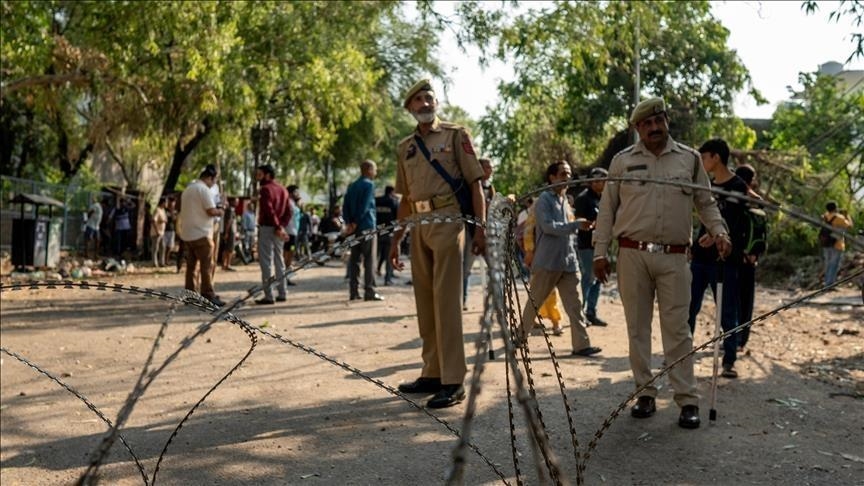OPINION - Uneasy truce and India-Pakistan conflict: Regional and global implications
Since independence of India and Pakistan, most of the conflicts and wars between the 2 have stemmed from Kashmir dispute. Recent developments however, mark a significant departure from this pattern

- Recent conflict between India and Pakistan reflects a broader trend, whether viewed through the lens of the US–China trade war initiated by Trump or the perceived decline of the liberal international order
The author is an associate professor of political science and public administration at Yildirim Beyazit University in the Turkish capital, Ankara.
ISTANBUL
Following the April 22 terrorist attack in Pahalgam, in Indian-administered Kashmir, killing 26 civilians, most of them Indian tourists, Pakistan strongly condemned the act of terrorism and firmly rejected India’s allegations of its involvement in the massacre. However, on May 7, India launched Operation Sindoor, conducting missile strikes, drone attacks, and airstrikes on Pakistan-administered Kashmir as well as six cities near the Indian border. It was obvious that the attack was a unilateral move by India, aimed at retaliating against Pakistan.
Since the attack in Pahalgam, India has directly held Pakistan responsible for the incident. Moreover, without presenting concrete evidence, following diplomatic protocols, or informing any international bodies such as the UN, India unilaterally decided to launch an attack on Pakistan. Indeed, India has often pointed to links between past massacres on its territory or in Indian-administered Kashmir and terrorist groups, such as Lashkar-e-Taiba (LeT), which is designated a terrorist group by the UN, the US, Russia, India, and even Pakistan.
However, over the past few years, Pakistan has witnessed hundreds of terrorist attacks and massacres targeting its civilian population. These incidents have largely been carried out by the same or ideologically similar terrorist groups. Consequently, Pakistani authorities have consistently argued that there is no justification or strategic interest for Pakistan to provide safe havens for such militant groups to operate within its territory.
What happened?
Following India’s May 7 military actions on Pakistani territory, which reportedly struck six cities and killed approximately 31 civilians – including women, the elderly, and children – and destroyed civilian infrastructure such as mosques and homes, concerns were raised about the targeting of non-combatants. While India has argued that those killed were allegedly linked to terrorist activities, the incident has sparked significant controversy and criticism, particularly over the impact on civilian lives and infrastructure.
In retaliation, Pakistan launched attacks on Indian military bases, mostly located in Indian-administered Kashmir. Notably, one of the most significant developments in the escalation was the aerial combat which took place May 7 between fighter jets from both countries. Some observers have described it as one of the largest and longest dogfights in recent aviation history [1], marking a critical moment in the military standoff between India and Pakistan.
During the dogfight, Pakistani officials claimed to have shot down five Indian aircraft, including a French-made Rafale jet [2], and some US and French reports appeared to confirm that a Chinese-built Pakistani fighter downed at least two Indian planes [3]. The Indian Air Force later acknowledged the losses, stating, “Losses are part of combat, but all pilots have returned home,” [4] emphasizing that no personnel were left behind despite the damage sustained.
Conflict with complexities: Why it matters
Since the independence of India and Pakistan, the majority of conflicts and wars between the two countries have stemmed from the Kashmir dispute. However, recent developments mark a significant departure from this pattern. The current tensions are no longer confined solely to the Kashmir issue; they reflect broader regional and global dynamics, particularly those unfolding in Asia and the Indo-Pacific region.
The dogfight highlighted the rapid advances in Chinese military technology, demonstrating its growing competitiveness and, in some cases, superiority over certain Western defense systems. The aerial combat, which reportedly involved nearly 125 fighter jets over the span of one hour, has been described by observers as among the largest dogfights in recent aviation history. The performance of the Chinese-made J-10 fighter jets stood out, particularly its effective use of air-to-air missiles against Indian aircraft, with the latter mainly of Western origin.
In academia, "power transition theory" is frequently employed to analyze the dynamics between emerging and established powers [5]. Recent conflicts indicate that China’s challenge to US dominance extends beyond the economic sphere into the military domain as well. These developments reflect a shifting global order in which China is increasingly asserting its strategic influence. The India-Pakistan confrontation, in this context, can be viewed as a potential testing ground for field-level military capabilities and technologies, demonstrating how regional conflicts are becoming intertwined with broader geopolitical rivalries.
Interestingly, in diplomatic terms, the central question is not whether Pakistan achieved a decisive victory, but rather the noticeable lack of international support for India. Major Western partners such as the US, France, or the UK, as well as traditional allies from the East like Russia, and even Middle Eastern partners such as Israel or the United Arab Emirates, have refrained from offering direct support for India’s position. Conversely, Pakistan got explicit and sustained backing from countries such as China and Türkiye. For India, as a regional power and emerging global player, this represents a significant diplomatic setback, highlighting the urgent need for a strategic reassessment of its current foreign policy approach.
Uneasy ceasefire: What then?
After four days of intense military conflict, on May 10, India and Pakistan agreed to an uneasy ceasefire. However, it is crucial to acknowledge that as long as the Kashmir dispute remains unresolved, any ceasefire between India and Pakistan is likely to be temporary and fragile. The deep-rooted nature of the Kashmir issue continues to fuel tensions between these two nuclear-armed states, making sustainable peace elusive and any cessation of hostilities inherently unstable.
Beyond India’s strategic focus on Pakistan, particularly in Pakistan-administered Kashmir, it can be argued that India’s longstanding regional hegemony has been significantly undermined, at least for the time being. Regardless of whether this perception stems from Pakistan’s effective propaganda or reflects the real geopolitical consequences of the recent conflict, it is clear that India now faces the urgent task of restoring its regional influence and international standing. Until it does so, a renewed confrontation between India and Pakistan may be held in abeyance – not due to resolution, but due to recalibration. In essence, the current ceasefire appears to be not a lasting peace, but a temporary lull – a brief pause before the next storm in South Asia’s volatile strategic environment.
Where are geopolitical, geostrategic, and geo-economic goals heading?
Since the introduction of China’s Belt and Road Initiative in 2013, the Asia and Indo-Pacific region has emerged as a central arena for evolving geopolitical dynamics and strategic realignments. A pivotal development in this context was the initiation of the China-Pakistan Economic Corridor in 2017, which significantly reinforced China’s influence in both regional and global politics, particularly in the Indian Ocean region.
In response, the US and its Western and regional allies have introduced strategic initiatives to counterbalance China’s growing footprint. These include the Indo-Pacific Strategy, the Quadrilateral Security Dialogue, AUKUS (Australia, the UK and US), and economic frameworks such as the India–Middle East–Europe Economic Corridor (IMEC). However, recent escalations, including Israel’s attack on Palestine and India’s military actions against Pakistan, have overshadowed discussions around IMEC’s potential. These boundaries prompt critical reflection on whether the world is witnessing the emergence of a "new Cold War" or a modern form of "proxy warfare" among major powers and also in the region which covers South, Southeast, East, West, and Central Asia.
The recent conflict between India and Pakistan reflects a broader trend: whether viewed through the lens of the US-China trade war initiated by Trump or the perceived decline of the liberal international order, the emerging global order appears increasingly chaotic, volatile, and lawless. Furthermore, the integration of artificial intelligence (AI) and advanced military technologies is transforming the nature of modern warfare, potentially redefining global power hierarchies and shaping the dynamics of a new world order.
[1] Pakistan-India fighter jet “dog fight” was one of the largest and longest in recent aviation history, a source says, CNN, May 8, 2025. https://www.cnn.com/world/live-news/india-pakistan-attack-kashmir-tourists-intl-hnk#cmaehu00l00003b6qe1qvr6z7
[2] It’s Thursday morning in India and Pakistan. Here's the latest on the conflict, CNN, May 8, 2025. https://www.cnn.com/world/live-news/india-pakistan-attack-kashmir-tourists-intl-hnk#cmaeeb67s00003b6wd8uiwxlo
[3] Exclusive: Pakistan's Chinese-made jet brought down two Indian fighter aircraft, US officials say, Reuters, May 9, 2025. https://www.reuters.com/world/pakistans-chinese-made-jet-brought-down-two-indian-fighter-aircraft-us-officials-2025-05-08/
[4] Indian air force says losses are part of combat, but all pilots back home, Reuters, May 11, 2025. https://www.reuters.com/world/asia-pacific/indian-air-force-says-losses-are-part-combat-all-pilots-back-home-2025-05-11/
[5] Islam, Md. N., & Nyadera, I. N. (2024). Emerging Middle Powers, Transitions, and the Role of Turkey in a Changing International Order. International Journal, 79(4), 489-509. https://doi.org/10.1177/00207020241299697
*Opinions expressed in this article are the author's own and do not necessarily reflect Anadolu's editorial policy.
Anadolu Agency website contains only a portion of the news stories offered to subscribers in the AA News Broadcasting System (HAS), and in summarized form. Please contact us for subscription options.







